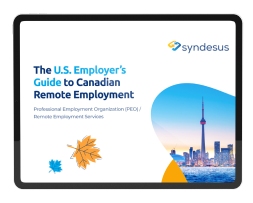In an era where businesses are increasingly seeking cost-effective and strategic ways to grow in global markets, nearshoring has emerged as a compelling option. For U.S. companies, Canada presents a particularly attractive choice for expanding their workforce. From favourable economic factors to operational efficiencies, the benefits of nearshoring to Canada are numerous and profound.

7 Reasons for Nearshoring to Canada
Healthcare Costs and Benefits
One of the most compelling reasons for U.S. companies to consider nearshoring to Canada is the significantly lower healthcare costs. Unlike the U.S., where healthcare expenses can be a substantial burden on both employers and employees, Canada’s publicly funded healthcare system alleviates many of these financial pressures. Employers in Canada benefit from lower health insurance premiums and reduced administrative overhead related to employee health benefits. This can translate into considerable savings, allowing U.S. companies to allocate resources more efficiently and invest in other areas of their business.
Competitive Salaries
Canadian salaries, while competitive, tend to be lower than those in the U.S. for equivalent roles. This wage differential allows U.S. companies to access skilled talent at a more affordable rate. Additionally, the cost of living in many Canadian cities is lower than in major U.S. metropolitan areas, which helps balance out compensation expectations. By leveraging this cost advantage, businesses can optimize their expenditure on human resources while still attracting and retaining top talent.
Canadian Grants
There are many grants available for engineering teams and innovative companies in Canada such as IRAP, SR&ED tax credits, co-op hiring tax credits, Mitacs Accelerate grants, Ontario Centre for Innovation. Companies can leverage their investments with these grants to maximize their efforts and returns.
Culture and Language
Cultural and language compatibility is another crucial factor that makes Canada an ideal nearshoring destination. English is one of the official languages in Canada, and the country’s cultural norms are closely aligned with those of the United States. This similarity minimizes the potential for miscommunication and fosters a more seamless integration of Canadian employees into U.S. corporate teams. When compared to other international markets, this shared cultural and linguistic background significantly reduces the barriers to effective collaboration and operational synergy.
Same Time Zone and Proximity
Proximity in terms of time zones is a practical advantage that enhances productivity and communication. Canada, particularly regions like Eastern and Central Canada, operates within a similar time frame to the U.S., which facilitates real-time communication and coordination. Unlike offshore locations with significant time differences, Canadian nearshore teams can engage in synchronous meetings, support in-person meetings, and ultimately ensuring that projects teams can be stronger and projects stay on track.
Currency Benefits
The exchange rate between the U.S. dollar and the Canadian dollar presents another financial advantage. Historically, the Canadian dollar has been weaker than its U.S. counterpart, which means that U.S. companies can benefit from lower salary costs while maintaining a high standard of talent. This currency disparity can provide a significant cost-saving opportunity without compromising on the quality of the workforce.
Canadian Immigration and Local Employment Laws
The Canadian immigration system provides many advantages to help retain employees in the US, or nearshore talent from other countries. With predictable and reliable immigration programs, there are many different Canadian visas for the global workforce to relocate to Canada for strategic reasons.
Expand business to Canada with an Employer of Record (EOR) or Professional Employment Organization (PEO)
Expanding internationally can be complex due to different employment laws, payroll, and HR management. An EOR or PEO can simplify this process and often costs less than setting up a foreign entity. These organizations charge predictable per-employee fees, offering significant cost savings.
EORs act as the legal employer, managing compliance with labor laws, payroll, and taxes. This allows businesses to hire internationally without establishing a legal entity, avoiding compliance issues. For U.S. companies expanding into Canada, an EOR ensures compliance with local regulations and streamlines the process.
Additionally, EORs and PEOs facilitate hiring local talent, providing access to skilled professionals familiar with the local market. This broadens the talent pool without the usual legal and logistical challenges of international recruitment.
Ensuring Compliance with Local Labor Laws
Compliance with local labor laws is essential for any U.S. company looking into global expansion. These laws cover a wide range of areas, including employee rights, working conditions, and benefits. Partnering with an EOR or PEO ensures adherence to these regulations, minimizing the risk of legal complications and penalties. These organizations stay updated on changes in labor laws and provide the necessary expertise to ensure that all employment practices comply with Canadian standards.
Navigating Legal Complexities with a Legal Employer
When expanding into Canada, U.S. companies must navigate various legal complexities. Partnering with an Employer of Record (EOR) or Professional Employment Organization (PEO) allows these businesses to designate a legal employer who assumes responsibility for compliance with local employment laws, payroll, and tax obligations. This simplifies the expansion process and ensures that all legal requirements are met without the need to establish a foreign entity.
Leveraging a Staffing Agency for Seamless Workforce Integration
Staffing agencies are crucial in helping U.S. companies nearshore their workforce to Canada. These agencies provide access to a pool of qualified candidates and facilitate the recruitment process, ensuring that businesses find the right talent quickly and efficiently. By working with staffing agencies, companies can streamline their hiring process, reduce time-to-hire, and ensure a smooth integration of Canadian employees into their operations.
5 Benefits of a Canadian Employer of Record or Professional Employment Organization
Regulatory Compliance
An EOR or PEO ensures that all local employment laws, including tax obligations, benefits administration, and labor regulations, are adhered to. This minimizes the risk of legal complications and penalties.
Streamlined Payroll Processing
Managing payroll across borders involves navigating different Provincial tax systems and currency exchanges. An EOR or PEO handles these complexities, ensuring accurate and timely payroll management for Canadian employees.
Canadian (Local) Expertise
EORs and PEOs bring local expertise to the table, offering insights into regional market practices and employee expectations. This can help U.S. companies tailor their HR strategies to better align with Canadian norms and improve employee satisfaction.
Efficient Onboarding and Administration
The administrative burden of hiring and managing employees in a foreign market can be substantial. An EOR or PEO simplifies onboarding processes and handles day-to-day HR tasks, allowing U.S. companies to focus on their core business activities.
Scalability
As business needs evolve, an EOR or PEO provides the flexibility to scale the workforce up or down with ease. This agility is particularly beneficial for companies testing new markets or adjusting their operational strategies.
Conclusion
Nearshoring to Canada offers U.S. companies a range of benefits, from lower healthcare costs and similar cultural alignment to advantageous time zones and currency savings. The combination of these factors creates a compelling case for considering Canada as a strategic expansion destination. However, to fully realize these advantages and navigate the complexities of international employment, partnering with an Employer of Record or Professional Employment Organization can be a game-changer. These organizations provide the expertise and infrastructure necessary to streamline HR and payroll processes, allowing U.S. companies to focus on growth and innovation. Additionally, an EOR simplifies the process of hiring international talent, making it a more attractive option compared to establishing a company entity in another country. By leveraging the benefits of nearshoring and the support of an EOR, U.S. companies can expand their global footprint efficiently and effectively.
Take the Next Step in Your Canada Biz Expansion Journey
Syndesus can assist with all these aspects, providing the expertise and support needed to ensure a smooth and efficient expansion into the Canadian market.
If you have any questions or need further assistance in your nearshoring journey, feel free to reach out. We’re here to help you navigate the process and make the most of the opportunities that nearshoring to Canada presents.
The content and materials available via Syndesus are for informational purposes only and do not constitute legal advice.

